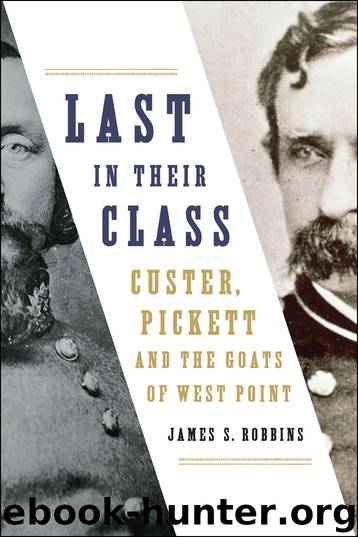Last in Their Class by James S. Robbins

Author:James S. Robbins
Language: eng
Format: epub
Publisher: Encounter Books
Published: 2017-02-15T16:00:00+00:00
LAURENCE SIMMONS BAKER
WRITING LONG AFTER THE EVENTS at Gettysburg, Henry Heth echoed what was by then a common critique of the battle: “The failure to crush the Federal army in Pennsylvania in 1863, in the opinion of almost all the officers of the Army of Northern Virginia, can be expressed in five words—the absence of our cavalry.”1 When General Lee moved north, he had given J. E. B. Stuart some discretion on his route, ordering him only to stay in contact with the right flank of the Army of Northern Virginia. Stuart took a liberal view of his mission. On June 25, as the rest of the army marched north up the valley behind the mountains, he headed east into Maryland, swinging around the Union right flank, seeking to raid supplies and create confusion. But with the Union forces between himself and the Confederate main body, he could no longer communicate with Lee, thus leaving the Army of Northern Virginia blind to the movements of the forces massing to intercept them.
Colonel Laurence Simmons Baker was one of Stuart’s officers, commander of the First North Carolina Cavalry. Baker hailed from a notable North Carolina family. His grandfather and namesake commanded a regiment in the Revolution and was a Federalist delegate to the North Carolina convention to debate the Constitution. Baker attended Norfolk Academy in his native state and was appointed to West Point in 1847. He was not a distinguished student, coming in consistently at the lower end of his class and ultimately graduating as the Goat of 1851. He was commissioned in the Mounted Rifles and served on the frontier, first in Kansas and the Dakota Territory, later in Texas and New Mexico. During the latter tour he fought a skirmish with the Kiowa at Ojo del Muerto (Dead Man’s Springs) on March 12, 1857.
Baker joined the Confederacy in May 1861, and within a year he commanded the First North Carolina. Like many cavalry officers, Baker was known for his dash. In June 1862, during the Seven Days Battles outside Richmond, Baker made a forced march from North Carolina and was thrown into the line, commanding all cavalry not then with J. E. B. Stuart. Lee ordered Baker to make a night scout on June 29 to ascertain the location of Union forces retreating after the Battle of Savage’s Station. Baker led five companies of his regiment towards the town of Willis Church, where there was rumored to be an enemy camp. As Baker moved down the Quaker Road, he encountered a small group of Union cavalry and charged them with sabers, believing them to be a minor covering force. The Federal horsemen broke, and Baker rushed his command forward towards the campfires just ahead, bursting through the perimeter and into the center of the encampment. There he made an important discovery. “I was compelled afterward to retreat from their camp,” he noted laconically in his report, “which I found to be their main army.” His men came under heavy
Download
This site does not store any files on its server. We only index and link to content provided by other sites. Please contact the content providers to delete copyright contents if any and email us, we'll remove relevant links or contents immediately.
| American Revolution | Civil War |
| US Presidents |
Fanny Burney by Claire Harman(26248)
Empire of the Sikhs by Patwant Singh(22773)
Out of India by Michael Foss(16695)
Leonardo da Vinci by Walter Isaacson(12809)
Small Great Things by Jodi Picoult(6691)
The Six Wives Of Henry VIII (WOMEN IN HISTORY) by Fraser Antonia(5241)
The Wind in My Hair by Masih Alinejad(4849)
The Crown by Robert Lacey(4577)
The Lonely City by Olivia Laing(4572)
A Higher Loyalty: Truth, Lies, and Leadership by James Comey(4556)
The Iron Duke by The Iron Duke(4125)
Millionaire: The Philanderer, Gambler, and Duelist Who Invented Modern Finance by Janet Gleeson(4107)
Sticky Fingers by Joe Hagan(3916)
Papillon (English) by Henri Charrière(3913)
Joan of Arc by Mary Gordon(3788)
Alive: The Story of the Andes Survivors by Piers Paul Read(3737)
Stalin by Stephen Kotkin(3728)
Aleister Crowley: The Biography by Tobias Churton(3429)
Ants Among Elephants by Sujatha Gidla(3282)
